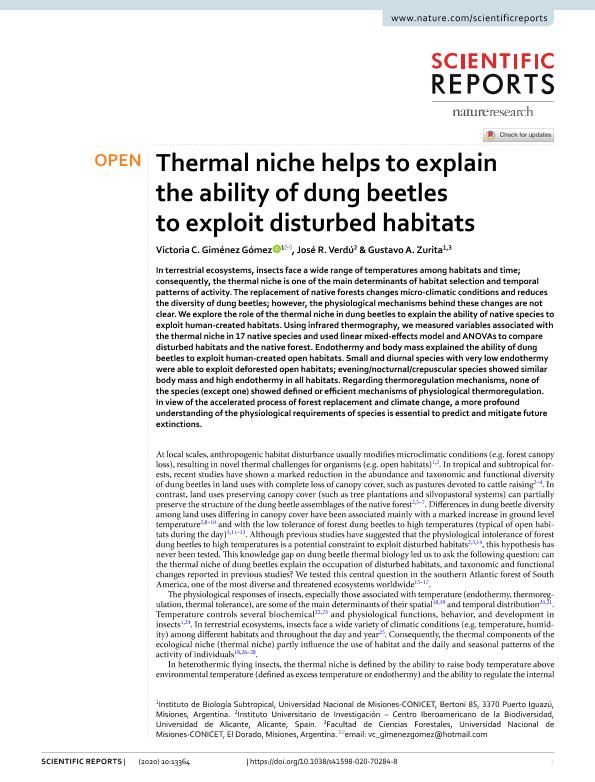Artículo
Thermal niche helps to explain the ability of dung beetles to exploit disturbed habitats
Fecha de publicación:
08/2020
Editorial:
Nature Publishing Group
Revista:
Scientific Reports
ISSN:
2045-2322
e-ISSN:
2045-2322
Idioma:
Inglés
Tipo de recurso:
Artículo publicado
Clasificación temática:
Resumen
In terrestrial ecosystems, insects face a wide range of temperatures among habitats and time;consequently, the thermal niche is one of the main determinants of habitat selection and temporalpatterns of activity. The replacement of native forests changes micro-climatic conditions and reduces the diversity of dung beetles; however, the physiological mechanisms behind these changes are not clear. We explore the role of the thermal niche in dung beetles to explain the ability of native species to exploit human-created habitats. Using infrared thermography, we measured variables associated with the thermal niche in 17 native species and used linear mixed-effects model and ANOVAs to compare disturbed habitats and the native forest. Endothermy and body mass explained the ability of dung beetles to exploit human-created open habitats. Small and diurnal species with very low endothermy were able to exploit deforested open habitats; evening/nocturnal/crepuscular species showed similar body mass and high endothermy in all habitats. Regarding thermoregulation mechanisms, none of the species (except one) showed defined or efficient mechanisms of physiological thermoregulation. In view of the accelerated process of forest replacement and climate change, a more profound understanding of the physiological requirements of species is essential to predict and mitigate future extinctions.
Palabras clave:
DUNG BEETLES
,
THERMAL NICHE
,
RESPONSE MECHANISMS
,
DISTURBED HABITATS
Archivos asociados
Licencia
Identificadores
Colecciones
Articulos(IBS)
Articulos de INSTITUTO DE BIOLOGIA SUBTROPICAL
Articulos de INSTITUTO DE BIOLOGIA SUBTROPICAL
Citación
Gimenez Gomez, Victoria Carolina; Verdú, José R.; Zurita, Gustavo Andres; Thermal niche helps to explain the ability of dung beetles to exploit disturbed habitats; Nature Publishing Group; Scientific Reports; 10; 13364; 8-2020; 1-14
Compartir
Altmétricas




